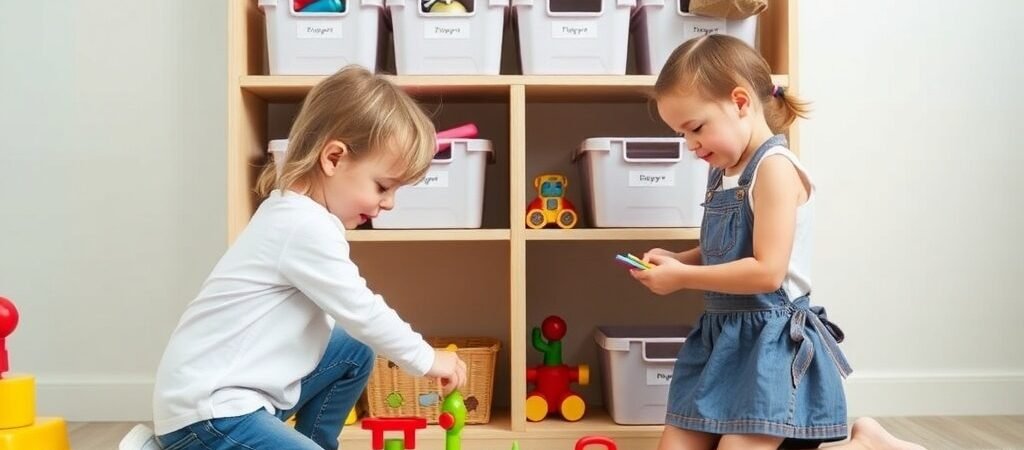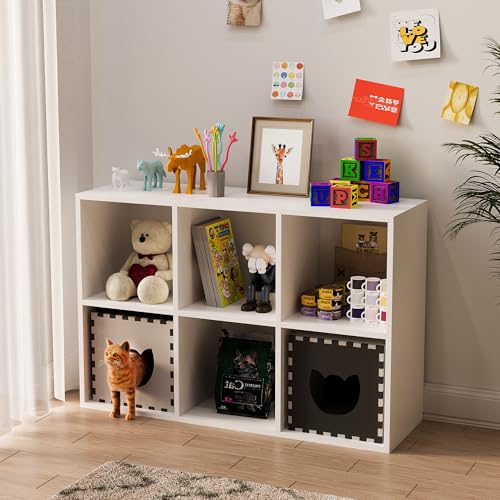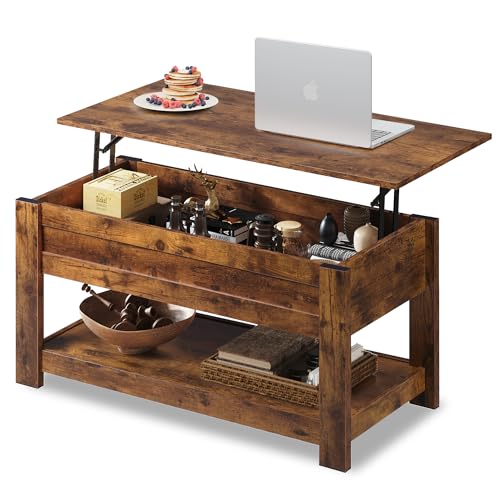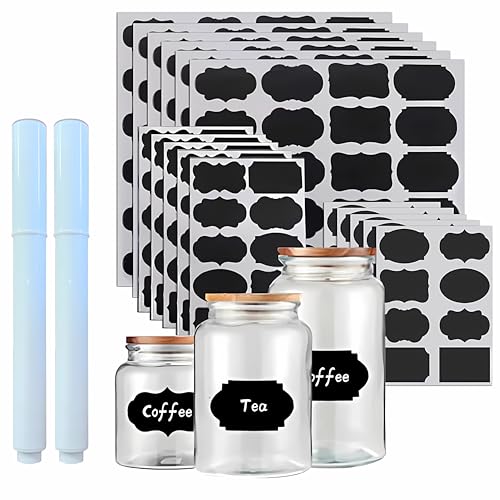How I Tamed the Toy Clutter
I’ll be the first to admit it: my home was once overrun by toy clutter. On any given day, I could find myself stepping on stray LEGO bricks or digging stuffed animals out of the couch. As a mom living in a small house, I know the struggle of trying to contain an explosion of toys in a limited space. (If you’ve ever uttered “We need more storage for all these toys!” you’re not alone.) A study once found the average middle-class family had 139 toys visibly on display (with even more stashed away out of sight). No wonder it feels like toys can take over our living rooms and playrooms! Not only is a cluttered space stressful for us parents, but “shelves overflowing with cars and blocks and action figures can be just as stressful for kids”.
The good news is that with some smart toy storage strategies, even a small playroom (or no playroom at all) can become a tidy, enjoyable space. Over the years, I’ve experimented with all sorts of toy room storage ideas to organize my kids’ things. Today, I’m excited to share the toy storage solutions that finally worked for me. From tall toy storage units that use vertical space to sneaky ways of hiding toys in plain sight, these tips have transformed my home. Let’s dive into my favorite tips and products that help any family (especially us moms with small homes and small kids’ playrooms) regain control over the toy clutter!
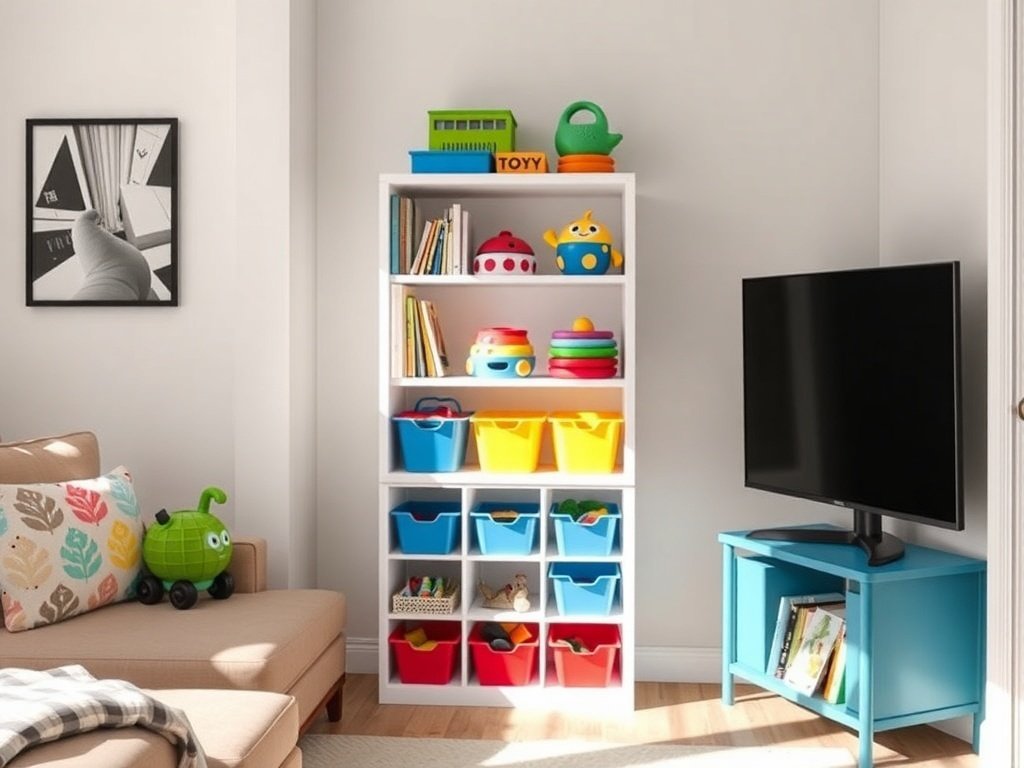
Why Toy Clutter Happens (And Why Organization Matters)
Before we jump into solutions, it helps to understand the problem. Kids accumulate toys at an astonishing rate—birthdays, holidays, and generous grandparents all contribute to the pile. (Fun fact: American kids make up only 3.1% of the world’s children, but purchase 40% of the world’s toys!) It’s no surprise that we parents often feel like we’re drowning in toys. The disorganization that results isn’t just a visual issue; it can make family life more stressful. We spend time searching for missing puzzle pieces and feel anxious in messy rooms. Research even shows that disorganization – not lack of space – causes 80% of household clutter. That means the key to a calmer, cleaner home isn’t necessarily a bigger house—it’s better organization.
Once I started giving every toy a proper place and involving my kids in cleanup, our home felt instantly bigger. We could play in the living room without tripping on things, and my kids started playing more with their toys (because they could find them!). Organizing isn’t about perfection; it’s about creating a space where your family can thrive. Now, let’s talk solutions — the fun part!
Think Vertical: Tall Toy Storage is Your Small Space Superhero
One of the best tricks I discovered for our cramped play area was to go vertical. When you can’t spare much floor space, tall toy storage solutions are a lifesaver. Think of stacking up rather than spreading out. Using vertical space is like adding an extra closet to your room without the footprint!
Tall shelves and bookcases make fantastic toy organizers. I opted for a slender, tall bookshelf. Suddenly, all those action figures and craft supplies that were scattered on the floor had a home on a shelf. If you’re worried about the look, you can find stylish open shelving or a cube storage unit that blends with your decor. Each cube or shelf can hold different categories of toys (one for dolls, one for trucks, one for puzzles, etc.), which also helps teach kids where things go.
Don’t overlook wall space either. We hung floating wall shelves for lightweight toys and books, getting items off the floor. I even use the back of the door: an over-the-door organizer (the kind meant for shoes or accessories) is perfect for Barbie dolls, small cars, or art supplies. Another vertical trick I love is a toy hammock for stuffed animals – it hangs in the corner of the room and keeps those dozens of plush buddies up and out of the way, almost like a cute decoration.
Key vertical toy storage ideas:
- Tall bookshelf or cubby unit: Store a ton of toys upward instead of outward. Secure it to the wall and fill with labeled bins or baskets.
- Wall-mounted organizers: Try floating shelves or wall racks for books, Lego display shelves, or hanging baskets. Utilize that wall real estate!
- Hanging nets or hammocks: Great for stuffed animals or balls. They corral bulkier toys in an unused upper corner of the room.
By using vertical and tall toy storage, even a small kids’ playroom can gain a lot of extra storage without taking up precious floor space. It’s like magically creating more room in your room!
Double-Duty Furniture: Sneak Toy Storage into Your Living Space
In a small house, every piece of furniture needs to pull its weight. I learned to look for multi-purpose furniture that can also hide toys. It’s a bit like a superhero in disguise — by day it’s a stylish ottoman, by night it’s holding a mountain of LEGOs inside!
If your living room doubles as a playroom (as mine does), consider investing in a toy storage bench or storage ottoman. I have a bench in our family room that looks like regular seating but opens up to reveal a trove of toy trucks and dress-up costumes. Cleanup is as easy as lifting the lid and tossing everything in. Plus, it gives me extra seating when guests come over! Similarly, a storage ottoman can hold blocks, game controllers, or stuffed animals, all while serving as a comfy footrest or coffee table.
Speaking of coffee tables, there are coffee tables with built-in storage that are game-changers for toy organization. I use a coffee table that has drawers on one side and a lift-up top. Inside, we stash coloring books, crayons, and board games. When it’s playtime, my kids know exactly where to find their things, and when it’s adult time, all the toys disappear neatly out of sight.
Don’t forget about sofas and beds – they often hide secret storage potential. Under our couch, I slide flat plastic under-couch storage bins filled with seldom-used toys (like that giant train set that only comes out occasionally). In my child’s small bedroom, I use under-bed storage for toy overflow and extra linens. It’s like having hidden drawers where there weren’t any before.
My favorite multi-purpose toy storage furniture:
- Storage bench or chest: Place it against a wall or at the foot of a bed. It’s perfect for bulky toys and doubles as seating. (Ours holds all the dress-up costumes!)
- Ottoman or footrest with storage: Ideal for living rooms – toss the day’s toys in and put your feet up. Some come in kid-friendly patterns or durable leather that’s easy to clean.
- Coffee table with storage: Look for one with shelves, drawers, or a lift-top. It keeps puzzles and art supplies within reach but neatly hidden.
- Under-furniture bins: Shallow rolling bins can slide under a sofa, crib, or bed. Store toys that aren’t used daily, or rotate seasonally (e.g., stash the outdoor summer toys under the couch during winter).
By choosing double-duty furniture, you integrate toy organization into your living space seamlessly. Guests will have no idea that the elegant linen bench is actually full of action figures and blocks. And you get to reclaim your adult space without banishing the kids’ stuff entirely – it’s just cleverly tucked away.
Bins, Baskets & Labels: Toy Room Organization Like a Pro
No toy storage game plan is complete without the classic bins and baskets approach. It might sound simple, but using bins (and labeling them) truly revolutionized toy room organization for me. Picture a library for toys: every type of toy has its own “section” or container. This gives everything a home and makes cleanup a breeze – even my kids can help because they know where things belong.
I started by sorting toys into broad categories: blocks, dolls, arts & crafts, cars, dress-up, etc. Then I gave each category a bin or basket. I use a mix of plastic toy storage bins and pretty woven baskets for shelves in common areas. Clear plastic bins are fantastic for visibility (you and your child can see what’s inside at a glance), while decorative baskets work well in the living room where I want a nicer look. For our cubby shelf, I bought a set of fabric cube bins that fit perfectly and hide the visual clutter of mismatched toys.
Labels are your best friend here. I cannot overstate how much it helped to label each bin – it’s like giving toys an address. You can use a label maker or even just picture labels for pre-readers (print a photo of a Lego or doll and tape it to the bin). After we labeled our toy bins, my kids actually started putting things back where they go because it was clear and easy. It’s a small miracle! Labeled toy organizers with specific spots for each type of toy ensure that when it’s clean-up time, there’s no confusion.
Another pro tip: rotate toys by keeping a couple of bins out of circulation. I keep an “overflow” box of toys in a closet; every few weeks, I swap out some toys on the shelf with ones from the box. This keeps the playroom fresh and not overwhelmingly full. (Plus, the kids get excited about “new” toys that were just in storage for a while.) Remember, 80% of the items we keep are never used, so it’s okay to tuck some away and even donate or sell toys that your children have outgrown. Fewer toys out means less mess and more appreciation for what’s available.
Toy organization essentials:
- Plastic bins with lids: Great for stacking, especially for puzzles, Lego, or collections of small pieces. Go for clear ones [affiliate link] for easy identification, or color-code them by child or type.
- Wicker or fabric baskets: Ideal for open shelves or cube units. They look nice in a family room and can hold things like plush toys, balls, or larger items.
- Labels: Use text labels, picture labels, or even chalkboard labels, you can rewrite. Label shelves too (e.g., one shelf is dedicated to books, another to games).
- Toy chest or box: A classic toy chest can serve as a quick clean-up solution – just toss everything in – but try to use it for a specific set of toys (like all the dress-up clothes in one chest) so it doesn’t become a black hole of randomness.
- Toy rotation bin: Keep a spare bin in a closet for toy rotation or “toy time-out.” When the play area gets too crowded, move some toys into this bin for a break. In a few weeks, swap them back out. It keeps clutter down and interest up.
With bins, baskets, and a labeling system, toy room storage becomes so much easier to maintain. Everything has a place, and even a small playroom can look neat because the visual chaos is contained. Plus, you’re subtly teaching your kids sorting and organizing skills that will benefit them for life.
Small House, Big Solutions: Creative Toy Storage Hacks
Living in a small house, I’ve had to get creative beyond the usual furniture and bins. It’s like solving a puzzle – finding those unused nooks and crannies where a toy or two can live. Here are some of my favorite small house toy organization hacks that have made a big difference in our home:
- Use the Walls (even more): We talked about shelves, but think pegboards and hooks too. I mounted a pegboard on one playroom wall and hung lightweight toys and buckets of art supplies on it. It’s super versatile and grows with your child’s interests (today it’s hanging toy tools and a bucket of plastic dinosaurs; tomorrow it could be LEGO base plates or craft scissors).
- Behind-the-Door Storage: The back of a door can host a hanging shoe organizer (each pocket can hold small toys, Barbie outfits, toy cars) or a hanging rack with bins. It’s thin storage that doesn’t eat into the room space at all. We have one on the playroom door for Play-Doh tubs and painting supplies.
- Corners and Ceiling: Those room corners can do more than collect dust. Aside from corner shelves, I installed a corner tiered hanging basket to hold lightweight toys and craft materials. And for all those stuffed animals we did the toy hammock as mentioned, up near the ceiling in a corner. It adds a fun decor element while storing dozens of plushies that used to live on the floor.
- Portable Carts or Caddies: I have a rolling toy storage cart that lives in our hall closet. I It’s perfect if you don’t have a dedicated toy room. It can be tucked away out of sight.
- Furniture Hacks: Think beyond typical storage furniture. We once repurposed an old bookshelf into a toy cabinet by adding some doors on the lower half – instant closed storage. A small ladder shelf or even a decorative ladder rack can hold blankets and baskets of toys vertically in a stylish way (it gives a rustic-chic vibe and takes up very little space).
By using these creative hacks, we maximize every inch of space for playroom storage without sacrificing the livability of our home. Our rooms feel bigger now that toys aren’t strewn everywhere. Small house or big house, the goal is the same: give each toy a home so your home doesn’t feel like a giant toy box.
Maintaining the Momentum: Make Toy Organization a Habit
Once you’ve put these toy storage ideas into action, the next challenge is keeping it that way. (I’ll confess, there have been days I look around and think, “How did we make a mess this fast again?”) The trick is to build simple habits and get the kids involved in toy room organization as part of daily life. It doesn’t have to be all on you, and it doesn’t have to be perfect.
Here’s what worked for me to maintain our organized play space:
- Daily 10-Minute Tidy: Every evening, I set a timer for 10 minutes and my kids and I do a quick clean-up game. We race to see who can put away the most toys before the music stops. It’s amazing what you can accomplish in a short, focused burst.
- Everything in Its Place: Because we designated homes (bins, shelves, baskets) for each toy category, clean-up is straightforward.
- Involve the Kids (Make it Fun): Young kids actually love to help if you make organizing a game or use imagination. Sometimes we pretend we’re a cleaning crew on a mission, or we sing the cleanup song. For older kids, I explain that everyone plays a part in taking care of our home.
- Regular Purge & Rotate: Every few months (usually before birthdays or holidays), we do a toy purge together. We’ll donate toys that have fallen out of favor or are outgrown, and recycle broken items. I involve my kids by asking which toys they’re ready to share with someone else. This not only controls clutter but teaches generosity. Also, I keep up our toy rotation routine – rotating sets of toys in and out of storage – to keep the collection manageable and the kids interested in what they have.
- Stay Flexible: Our toy storage system isn’t set in stone. As my kids’ interests change, I adjust. When my son got into building blocks, we dedicated a bigger bin to them. Feel free to tweak your system. The best system is one that works for your family’s current needs.
Above all, be kind to yourself. Some days our living room still looks like a toy tornado hit it – and that’s okay! The idea isn’t to maintain a picture-perfect home at all times, but to have an easy way to recover from the mess when you need to.
Conclusion
By making toy cleanup a regular habit and involving the whole family, you’ll find that maintaining an organized playroom or living space gets easier over time. It’s a gift that keeps on giving – less stress for you, and a more mindful approach to belongings for your kids.
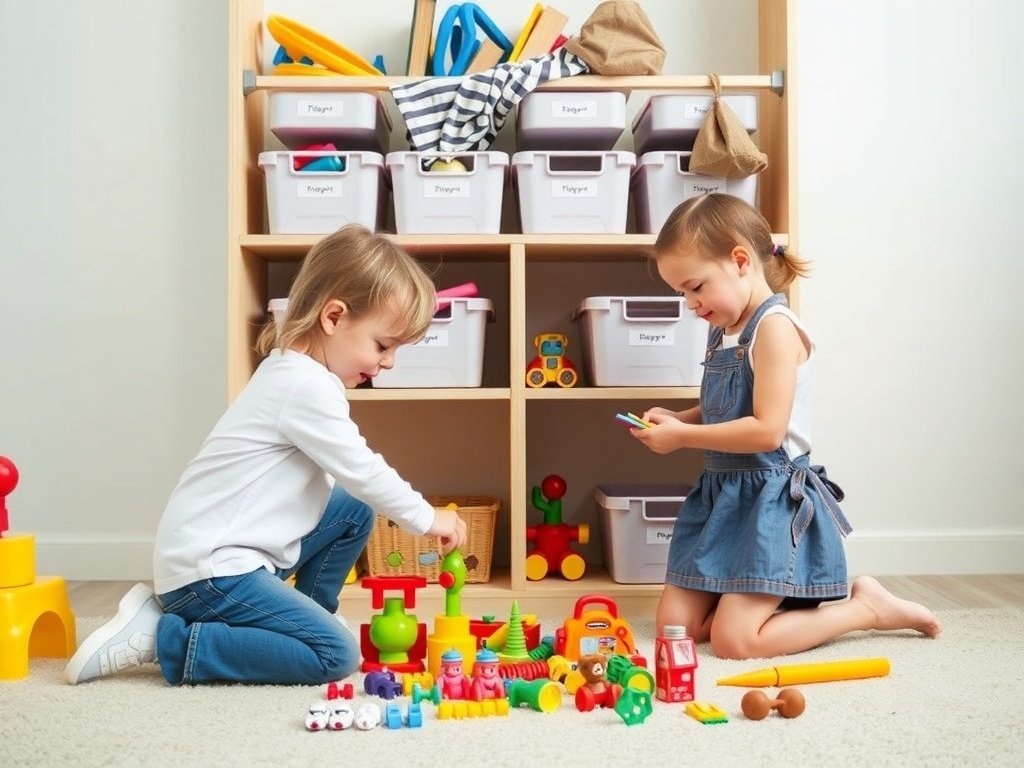
By implementing these toy storage tips, you’ll transform your space from chaotic to cozy. Trust me, as a mom who’s been there, done that, the effort is so worth it. A well-organized toy system means less stress, less mess, and more fun – for both you and your kids. No more midnight Lego incidents or frantic hunts for that missing puzzle piece. Just a home that feels a little more under control, even with energetic little ones running around.
Happy organizing, and here’s to a clutter-free, happy home! 🎉
Lisa, August 2025
